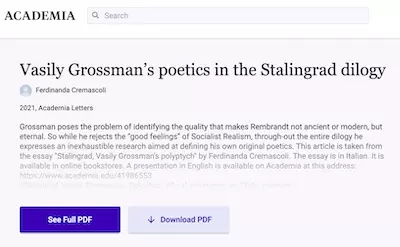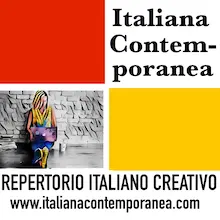Il saggio sulla poetica di Vasilij Grossman, pubblicato su Academia Letters.

Matisse once said, “If I use green, that doesn’t mean I’m about to paint some grass; if I use blue, that doesn’t mean I’m painting a sky.” Colour is simply an expression of the inner world of the artist.’ Viktor had wanted to please Yevgenia, but he couldn’t help adding mockingly: ‘Eckerman, on the other hand, said: “If Goethe were God, if he had created the world, he too would have made the grass green and the sky blue.” Those words mean a lot to me. After all, I’m not entirely a stranger to the material God formed the world from . . . Though of course I also know that there are no paints or colours, only atoms and the void between them.’ (Life and Fate, III, 39)
This exchange takes place between two characters of Life and Fate, (Žisn’i sud’ba) the second novel of Vasily Grossman’s Stalingrad dilogy. It is a discussion that takes place in Moscow during the terrible winter of 1942 between Shtrum, a nuclear physicist, and his sister-in-law Zhenya, an avant-garde painter. A completely plausible discussion in the Soviet Union of the 1940s where Socialist Realism defeated the theories of the Formalists and the experiments of every avant-garde, imposing precisely those “good feelings” that make bad literature. Vasily Grossman expresses a critical judgment about the avant-garde in this dialogue, but for other reasons he is also critical against the Socialist Realism.
Grossman poses the problem of identifying the quality that makes Rembrandt not ancient or modern, but eternal. So while he rejects the “good feelings” of Socialist Realism, throughout the entire dilogy he expresses an inexhaustible research aimed at defining his own original poetics. Already in the first novel of the dilogy, Stalingrad (Za pravoe delo) he theorizes the distinctive trait of universal art in simplicity.
In this clear, calm and deep simplicity lies the truth of genuine art. Such art is like the water of a spring; if you look down, you can see to the bottom of a deep pool. You can see green weeds and pebbles. Yet the pool is also a mirror; in it you can see the entire world where you live, labour and struggle. Art combines the transparency of glass and the power of a perfect astronomical mirror. All this applies not only to art; it is equally true of science and politics. And the strategy of a people’s war, a war for life and freedom, is no different. (Stalingrad, II, 2)
“True” art, or at least art according to the ambition of this writer, possesses at the same time two opposite qualities: transparency, like the “fourth wall”, favored by naturalism, and reflexivity, word that has a precise scientific sense: it is the return of a part of the energy of the light waves outside the reflecting surface.
This idea of reflexivity, as a product of waves, is not a mirror of a part of the world, perhaps defined by the artist a priori on the basis of his own poetics. On the contrary, it is a mirror of the world in its entirety, multiplicity and complexity. The work of art is therefore a cognitive investigation that strives to make intelligible what the mirror reflects. Vasily Grossman’s poetics is the belief that there is something in common between the artist’s and scientist’s research, as they both are cognitive processes of the world, although each one is conducted with their own, and distant, modalities.
In another place in the text, the idea of reflexivity is further specified, in the negative, in a sort of “reductio ad absurdum”. In Kazan, where he is displaced, one evening Professor Shtrum visits a group of friends at his colleague Sokolov’s house. They talk about literature and one of them, Sokolov’s brother-in-law, Mad’jarov, argues that Decadentism and Socialist Realism are essentially the same thing: the artists of these two schools have no cognitive ambitions, they simply tell small portions of the world.
People have argued over the definition of Socialist Realism. It’s a mirror: when the Party and the Government ask, “Mirror, mirror, on the wall, who’s the fairest of them all?” it replies, “You – Party, You – Government, You – State, you’re the fairest of them all!” While the decadents’ answer to this question is, “Me, Me, Me, I’m the fairest of them all.” Not so very different. Socialist Realism is the affirmation of the uniqueness and superiority of the State; the decadent movement is the affirmation of the uniqueness and superiority of the individual. Socialist Realism is the affirmation of the uniqueness and superiority of the State; the decadent movement is the affirmation of the uniqueness and superiority of the individual. The form may be different, but the essence is one and the same – ecstatic wonder at one’s own superiority. (Life and Fate, I, 64)
Therefore the “mirror” of Socialist Realism or Decadentism is a magical object, predictable in its lack of imagination. The veritable artwork is however recognized because it is ambitious. It is interested in everything. It has the ambition to know the reality that is seen and the one that is not seen; the social reality and the personal one; the historical reality and the inner one, the natural reality and that of human work.
Vasily Grossman wrote these pages in the 1940s and 1950s when Socialist Realism had long since defeated the avant-garde poetics and theories of the Formalists who energetically affirm the autonomy of literature and art, which highlight the internal reasons of artwork, refusing to be the flag of any ethics.
And yet Grossman’s position is critical of the Avant-gardes as well. In the novel, Zhenya is the avant-garde painter, far from Realism: “strange daubs no one can understand” (Stalingrad, I, 18), this is how Marusya defines her sister’s paintings, and, controversial, argues that “anyone can enjoy Repin and Surikov” (Stalingrad, I, 22)
And many pages later in Life and Fate it is the other sister Lyudmila who describes Zhenya’s paintings thus: “Green men, blue huts . . . It’s totally cut off from reality” (Life and Fate, III, 39). So it is by commenting on Zhenya’s works that the judgment on the avant-garde is manifested: their research is often aimed to the invention of the unheard, of the never realized, daring more and more, to the point of remaining prisoner of their texts so innovative and so impossible.
The judgment of the avant-garde is nevertheless more nuanced than the totally negative judgment on Socialist Realism. Even Zhenya, in her own way, pursues the cognitive value of the work of art, Zhenya who perhaps does not find the right means of expression, but nourishes precisely this ambition for her painting, the “heart” that Professor Shtrum recognizes in the two paintings who wanted to take himself as a displaced person to Kazan. It is not a child’s play to paint Stalingrad, a view of the Volga, in the days just before the destruction of the city; it is not a futile exercise, as Marusya thinks. Stalingrad in those fateful days is the sun, the sparkling river, the magnificent trees, the white buildings, … and above all this, the war: dark and severe faces, camouflaged boats and black smoke above the factories, and tanks going to the front, … All this, thinks Zhenya, is life: the sweetness and bitterness, the advancing darkness and the light that never goes out completely … And later on, when she is already in Kuibyshev in a community apartment, Zhenya would like to paint not so much the roommates, tight as sardines in a precarious and quarrelsome space, but the feeling they arouse in her.
There were many facets to these feelings. It seemed unlikely that even a great artist could give expression to them. They arose from the strange incongruity between the tremendous military strength of the Soviet State and this dark kitchen with its poverty, gossip and general pettiness; the incongruity between cold, hard steel and kitchen pots and pans full of potato peelings. The expression of these feelings would break up every line, distort figures and take the form of some apparently meaningless coupling of fragmented images and patches of light. (Life and Fate, I, 23).
From this derives the Grossmanian quest for a sense of the work of art, and ultimately a positive recovery of “good feelings”, in the ethical conviction that literature is a means of knowing oneself and the world.
